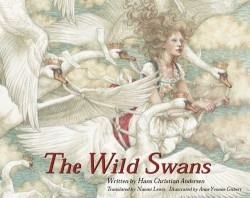The Wild Swans
April 2, 2005 marks the 200th anniversary of Hans Christian Andersen’s birth. This reissue of an early work proves that Andersen remains a master of the fairy tale, infusing the simple theme of good vs. evil with elements of magic and enchantment to create a hauntingly irresistible tale for readers of all ages.
Young Elisa and her eleven brothers are the children of a king, and live a life of royal luxury. The boys “wrote on gold slates with diamond pencils” and Elisa’s best picture book “cost half a kingdom.”
Everything changes when their father marries an evil queen who transforms the boys into wild swans and drives them from the palace, then convinces the king to banish Elisa from his court. Driven from her home, Elisa endures solitude, misunderstandings, and even the threat of execution as she tries to accomplish an impossible task, which is the only way to bring her brothers back to their human forms. The journey toward her “fairy tale ending” is arduous, but Elisa is resourceful, determined, and a heroine for readers to admire.
In a brief introduction, experienced Andersen translator Lewis provides well-made source notes that identify the first publication date of this story as 1837, and then supplies historical and cultural details that enhance the tale’s themes of flight and travel. Also included is a brief history of Andersen’s rise from a poverty-stricken child to “the best-known, most-loved Dane in the entire reading—and listening—world.”
The translation is in keeping with the formal yet direct narration that readers expect from a classic fairy tale. The plot moves quickly, but is sprinkled with descriptive imagery, both beautiful (“wonderful flowers, vast in size, like mill wheels”) and fearsome (“stinging nettles” which “scorched her skin like fire” or the lamias, “those witches that are half snake, half woman.”) The combination of simple storytelling and rich description evokes a magical setting, long ago and far away. Judicious use of dialogue enriches the tale and gives added appeal to this story as a read-aloud.
Realistic colored-pencil drawings illustrate the tale in a lush, vibrant style. Gilbert’s attention to the details of court and clothing highlight the European origins of this story, even as her meticulous renderings of fantastical elements like fairies, unicorns, and a menacing graveyard add to its otherworldliness.
The best fairy tales appeal to a wide audience of varying ages, and this book is among the finest of the classic European tales published recently. Libraries will want this book as a permanent addition to their fairy tale collections, and families will find that its universal appeal and depiction of strong love between siblings make it a wonderful read-aloud and a great springboard for discussion of “family values” that are really worth talking about: hope, loyalty, and love.
Reviewed by
Carolyn Bailey
Disclosure: This article is not an endorsement, but a review. The publisher of this book provided free copies of the book to have their book reviewed by a professional reviewer. No fee was paid by the publisher for this review. Foreword Reviews only recommends books that we love. Foreword Magazine, Inc. is disclosing this in accordance with the Federal Trade Commission’s 16 CFR, Part 255.

